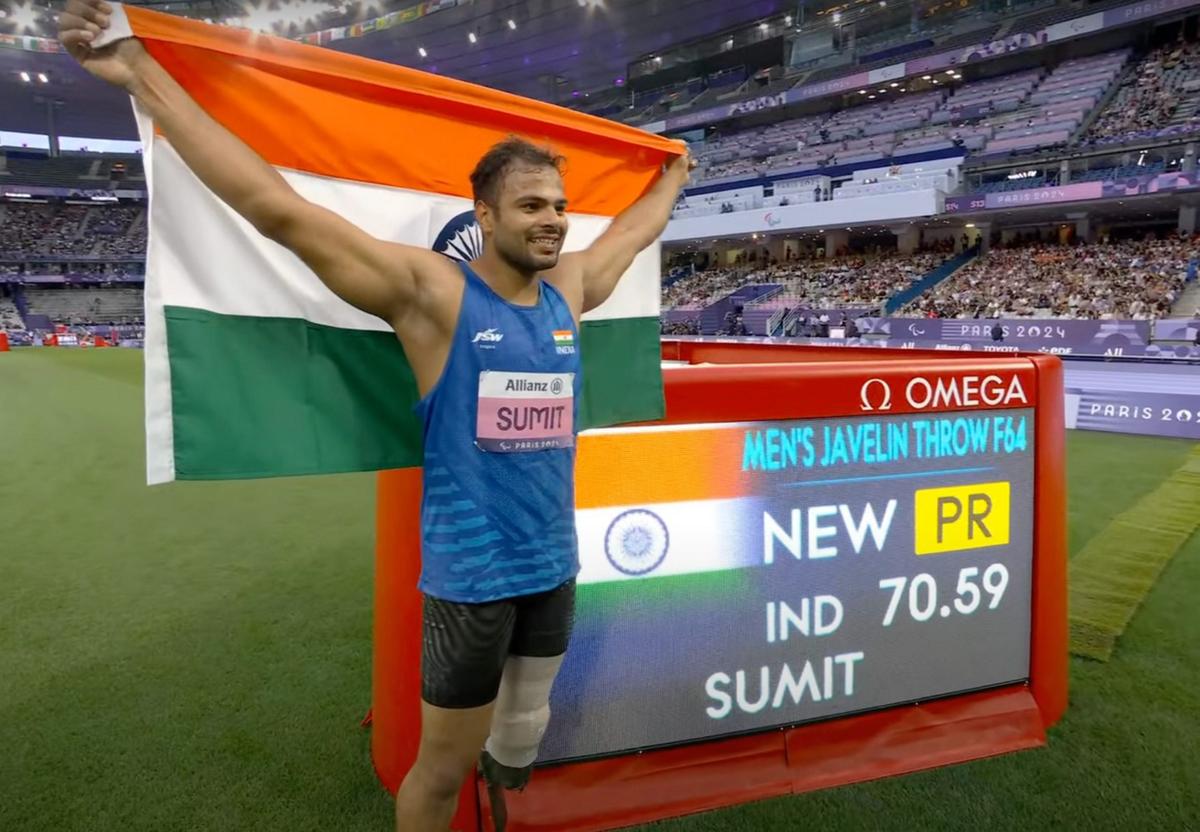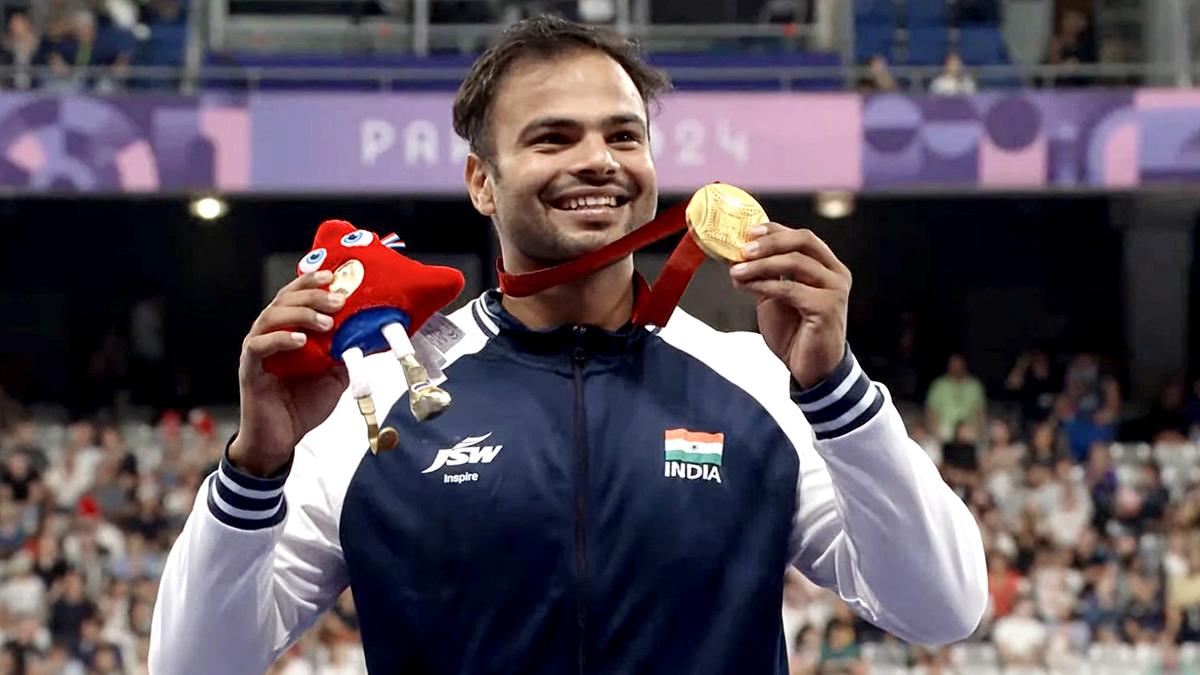With Paralympic crown retained, Sumit Antil sets three-peat target for LA 2028
If you were walking past Sumit Antil’s room in the Paralympic village a night before his big javelin final, there’s a chance you might have heard songs from the 2013 film Bhaag Milkha Bhaag. As sleep evaded him before the final of the men’s javelin event, some spine-tingling cinematic inspiration was the go-to remedy to run the clock down.
“When people have expectations, the responsibilities on you increase. I wanted to give my best. The pressure is internal to keep getting better and the fear is about being unable to do that well. I don’t read much, so meditation and some shorts from the film were how I passed the hours,” he told reporters a day after winning his second Paralympic gold.
That gold came with him breaking the Paralympic record twice. He began with a massive opening throw of 69.11m. This broke his own previous Paralympic record mark of 68.55m set in Tokyo. He then went one better with a 70.59m throw on his second attempt. No one else in the field came close to either distance, but Sumit’s competition was far from over. His last Paralympic gold came with the sweet garnish of a world-record (WR) mark.
“I didn’t think about the record,” Sumit admitted. “I thought about bettering my personal best (73.29m – the current WR mark for F64). We get so many facilities so the push is to validate all that with performances that improve with each try. That’s our responsibility. The only aim is to throw better today than I did yesterday,” he added.
The people on the men’s javelin podium remained the same in the Paralympics in Tokyo and Paris. Australia’s Michal Burian won silver three years back but got a bronze in Paris. Sri Lankan Dulan Kodithuwakku had bronze in Tokyo and silver in Paris. Sumit’s place at the top did not change.

Sumit Antil poses for photographs after winning the gold medal in javelin throw F64 event in Paralympics 2024.
| Photo Credit:
PTI
Sumit Antil poses for photographs after winning the gold medal in javelin throw F64 event in Paralympics 2024.
| Photo Credit:
PTI
In Japan, the world was still finding a way out of the COVID-19 pandemic. There were no crowds and no support outside the team’s appointed staff. In Sumit’s case, there was also no reputation to precede him. This time, the world knew him. The fans in Paris cheered him on at the start of his run-up. But the reason for the 26-year-old’s anxiety was his back injury.
“I didn’t have an injury before Tokyo. A back issue has been plaguing my performance for the past few months. It’ll get alright, it just needs some rest but I was participating in back-to-back events and didn’t get time to give my back the rest it needed,” Sumit said.
Javelin, for an able-bodied athlete, needs every engaged muscle to be in the best shape to execute a throw with perfection. Look at Neeraj Chopra in the Paris Olympics a few weeks ago. His adductor issue quite visibly stiffened his blocking leg, and the advantage he gained from his run-up speed was hampered. As was the force he could exert on that left leg.
“When you have an injury, you lose the support of those muscles in your throw. That load moves to some other muscle and it disturbs your technique. I felt that pain (in my back) after my third throw last night.”
That was a 66.66m throw, his second-lowest of the night. Right after, Sumit threw what looked like it went around the 67m mark but intentionally fouled his effort. Much like Neeraj, he knows when he hasn’t gone the distance his lofty standards demand.
“I just wanted to keep pushing my limits constantly. But it wasn’t happening and I was getting a bit frustrated. The throw was among my lower ones so I fouled. That throw too would have gotten me to the podium by itself, but I wasn’t happy with it,” he explained.
Sumit is a tall, big-built athlete which makes weight control that much more important to his technique and flexibility. The nagging back injury pushed the team physio, Vipin, to put Sumit on a strict diet that involved sacrificing sweets, something he grudgingly endures in the lead up to major events. It was that much more important this time as losing weight would reduce the strain on his spine. Sumit makes the block with the artificial limb, which makes life even harder.
Sumit Antil reacts after a throw during the Paralympics 2024.
| Photo Credit:
REUTERS
Sumit Antil reacts after a throw during the Paralympics 2024.
| Photo Credit:
REUTERS
“My landing leg is the one with the artificial limb and it’s difficult to balance on it sometimes because only the heel connects with the ground. It is hard to balance the full body on two nails. After doing all the work to set up the throw, it all comes down to the blocking leg. In the final here, too, I was losing balance. So, the throw was not as long as I wanted it to be,” he added.
With the injury working on his mind, Sumit needed to keep things as simple as possible. The advice he got from Neeraj Chopra before his campaign stressed the same.
“I didn’t speak to him [Neeraj] personally. My manager, Dinesh, spoke to Neeraj’s team and he passed on a message to me. He said that the atmosphere was great. ‘Don’t try anything new. Your experience will be fine’,” Sumit said.
Sumit’s best effort of the night was 3.56m more than that of silver medalist Dulan. This margin was just a touch higher than Arshad Nadeem’s lead over Neeraj in the men’s javelin Olympic final a few weeks ago. Nadeem’s monstrous 92.97m throw caught the world by surprise, but Sumit’s lead was expected.
His effortless pursuit of bettering his own world record often feels like Armand Duplantis’, the Swedish-American pole vaulter who has the top 10 best marks in his discipline. Sumit, too, has broken the world record at least eight times in the last five years and despite bursts of brilliance from his competitors, no one has come close. While his opponents aim for the 70m mark, Sumit has long set his sights on clearing 80 metres.
Much like Duplantis, watching Sumit compete is watching one man compete against himself, but he doesn’t particularly enjoy hearing it.
“The aim is simple. If I am at 70m today, then tomorrow I need to get to 71, 72. But it would be unfair to say I am competing with myself because the others are also throwing well. The Sri Lankan athlete threw 67m. It’s a new record in his category. The Australian athlete (bronze medallist Michal) has also been good. We can’t view anyone lightly. But we do focus and can control how to improve ourselves and our performance,” he explained.
He also had the company of veteran Sandeep Chaudhary (F44 class) during his event. The 28-year-old former world-record holder fell agonizingly short of a maiden Paralympic medal, finishing fourth with a best throw of 62.80m. The finish made it an unsavoury hattrick of fourth-place finishes for the Rajasthan athlete, who had finished just outside the medal places in Tokyo and Rio as well.
“Fourth-place finishes are very heartbreaking,” Sumit said. “I don’t think anything I can say can make that better. Sandeep trains in Germany and we don’t get to interact as often. He is my senior and we pass on notes during competition. After a certain level in elite sports, athletes don’t need someone to point out what’s happening with their technique. They know what to do. Everyone’s training style and schedule is different. So we try not to talk techniques much and focus on motivating each other.
Sandeep’s personal best is 66.18m which earned him the world record at the 2019 World Championships in Dubai. In Paris, a 65m throw would have earned him bronze, but it wasn’t to be.
“One throw of his yesterday looked like it was around 65m, but it ended up being a foul. Sandeep helped me a lot when I started. He is an inspiration for us all. He made the WR in 2019 with a 65m-plus throw. He broke that barrier first. He was the first to breach the 60m barrier too. So, he has been nothing but an inspiration,” Sumit added.
With the major event of the year out of the way, Sumit now has clear priorities. Number one — fix his back and bring his core to peak fitness again. Number two — make up for the time away from family.
The next big event on his radar is the World Championships next year, which India is hoping to host. The prospect of registering his next world record on home soil brings a little sparkle in Sumit’s eyes.
“My team and I view the event calendar in small portions. Immediately on my priority list is the World Championships next year. So the idea will be to perfect my body and technique as much as possible by then and give my best there.”
There’s also the chance of doing a three-peat at the Los Angeles Paralympics in 2028, and 26-year-old Sumit fancies his odds.
“As far as LA 2028 is concerned, I am 26 now. By then I’ll be 30. In our game, the peak age is around 31-32. It will be quite great to top the podium there too. The efforts will certainly be in that direction.”
With increasing attention on para-sports, support from government, and private sponsors flowing in for para-athletes, Sumit expects the glare around events to increase.
“I feel an athlete who doesn’t feel the pressure is either not taking the game seriously or is on another level of legend in their sporting arc. In my case, I did feel a lot of pressure. There was the pressure to maintain my position at this level and come good on people’s expectations from me. To stay consistent. It’s easy to reach the top but to remain consistent on top is the biggest challenge.”



